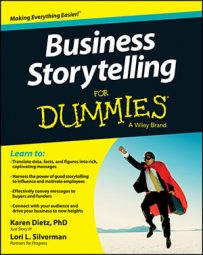There’s no reason to try to be funny or entertaining in your business story just because you believe that’s what people want to hear. Make sure the humor fits with the setting, is respectful, and actually enhances your story.
Sometimes in the darkest of moments, humor can jump in and relieve the intensity of a situation. In Pam’s story, one opportunity might be when she takes the little girl up to the front of the plane and makes a rattle. You could easily improvise, depending on the audience.
For example, you could step out of telling the story and make a comment directly to listeners — something like, “I’ll bet some of you here would like a flight attendant kit to use at work” and then pause for the laugh before turning back into the story.
Doug Stevenson, author of Doug Stevenson’s Story Theatre Method (Cornelia Press, 2008) says there are three dimensions to humor in storytelling:
Conceptual: Conceptual comedy is cerebral. Sit down with a pen and paper and make lists of funny words and phrases and silly ideas and concepts that relate to your story — and start mixing the ingredients, like a chemist.
Physical: How do you use your body, gestures, and facial expressions to invoke humor? Watch comedy shows and study the actors. For fun, watch a second time with the sound off. Note how they get laughs with or without words.
Vocal: Pay close attention to rhythm, tempo, volume, inflection, and timing. How you deliver your lines is key to success. You can have great lines and deliver them horribly and lose the vitality of that moment.
Here are techniques Doug Stevenson suggests to help add humor to a story:
The triple. Triples get a laugh because of structure. When you provide one for instance to illustrate a point, use three examples instead. The first two set a pattern; the third breaks it with a humorous twist.
Poke fun in a light-hearted way at common foibles and frictions in business and then provide a solution. Let’s use the example of a sales meeting. They’re often mandatory, boring, predictable, and too long. Try the techniques of a setup line (one or two short sentences) and the payoff (the laugh line).
Once again, it’s your turn. What can you do in your story to add humor?
Exaggerate to make your point
Exaggeration is a great embellishment device and comedic tool. Here are four ways to amplify characters, events, or obstacles to strengthen a point:
Exaggerate the characters and their personal characteristics such as physical body qualities and appearance. For example, you could exaggerate a character by identifying an administrative assistant as “Miss Gatekeeper.”
Or, if describing someone making a cup of coffee, go into extreme, minute detail that is way over the top. Both methods can make people laugh because many of them have experienced something similar. Be mindful of your audience if you elect to use this approach.
Exaggerate an element of the story. Examples of elements include time (after six weeks, seven government holidays, and another 150 days of haggling), the size or dimensions of an item (it wasn’t just a large box, it was the size of Fort Knox), and something about geography or the location (New York City isn’t just five boroughs, it’s the center of the universe).
It’s okay to exaggerate beyond belief, too. Instead of saying, The meeting didn’t go well, you could say, World War III began in that meeting on Friday. There were hand grenades being lobbed over and under the table.
Use repetition for emphasis and more punch. We’re not talking about being redundant and putting people to sleep by saying something like, The value of having values is the value they bring to your organization’s value proposition. You don’t want repetition to become your enemy. Here are some good examples:
Add the same word in a repetitive phrase. For example: . . .that we shall pay any price, bear any burden, meet any hardship, support any friend, oppose any foe to assure the survival and the success of liberty. Here, John F. Kennedy uses the word any five times to emphasize the point being made in his 1961 inaugural address.
An advertising jingle also demonstrates this type of repetition, which you can use in a story: I’m a Pepper, he’s a Pepper, she’s a Pepper, we’re a Pepper — wouldn’t you like to be a Pepper, too? Be a Pepper, drink Dr. Pepper.”
Repeat a word or phrase at the beginning of a sentence. Select a word or phrase that would benefit your story through repetition at the beginning of each sentence in a section.
Winston Churchill did this when he delivered a speech to the United Kingdom’s House of Commons on June 4, 1940: “We shall fight on the beaches, we shall fight on the landing grounds, we shall fight in the fields and in the streets, we shall fight in the hills.”
Repeat a word or phrase at the end of a sentence. This section of Abraham Lincoln’s Gettysburg Address is an example: “. . . and that government of the people, by the people, for the people shall not perish from the earth.”
Leverage the physical. Use body movements, facial expressions, and varied vocal tone and volume when delivering different parts of the story to reinforce it. In Pam’s story, when she talks to the little girl, she could exaggerate her tone as she would if she were talking to a little girl. She could also simulate kicking when talking about the little girl’s behavior.
Before reading further, which technique might you use with your story?

